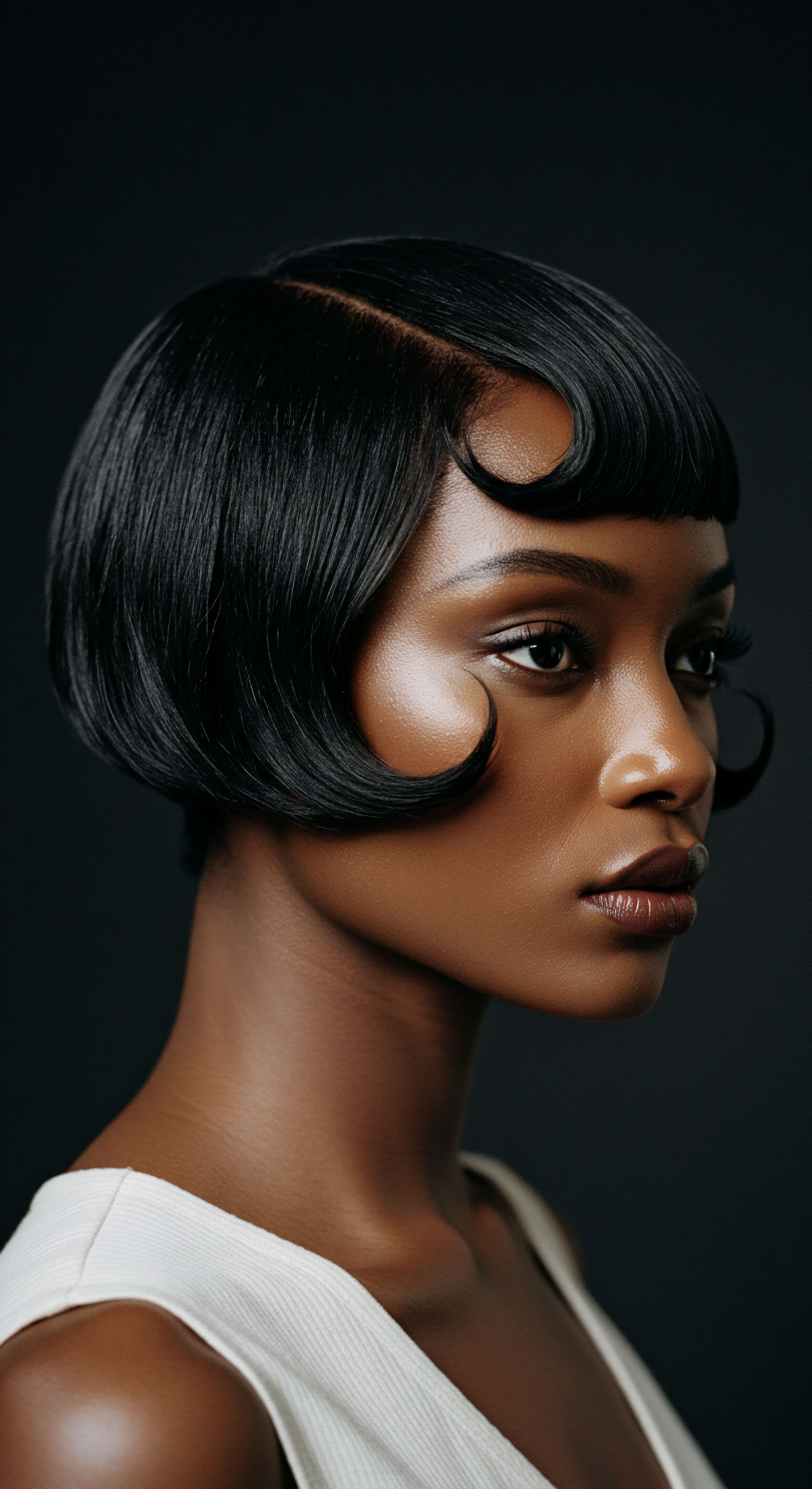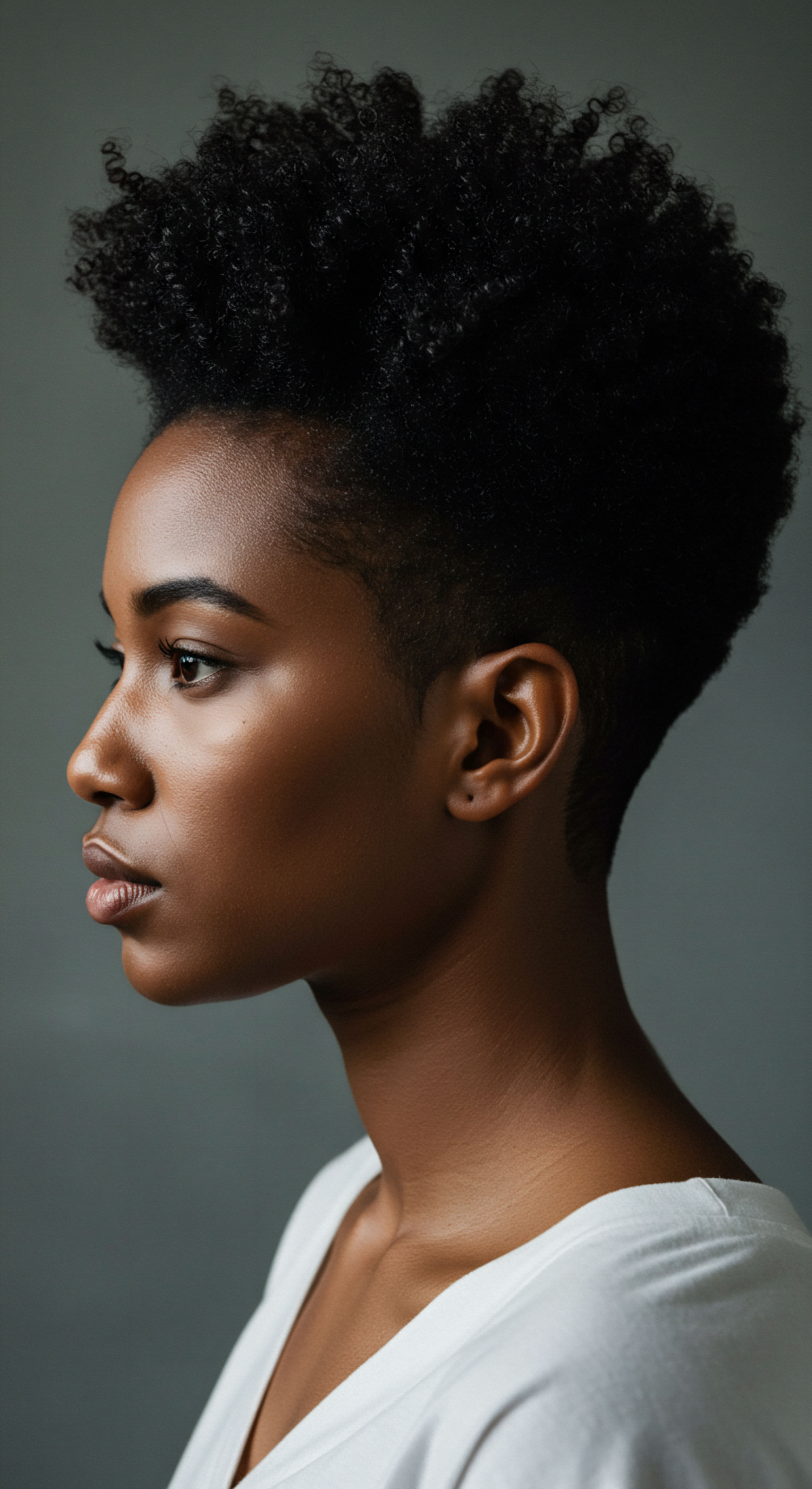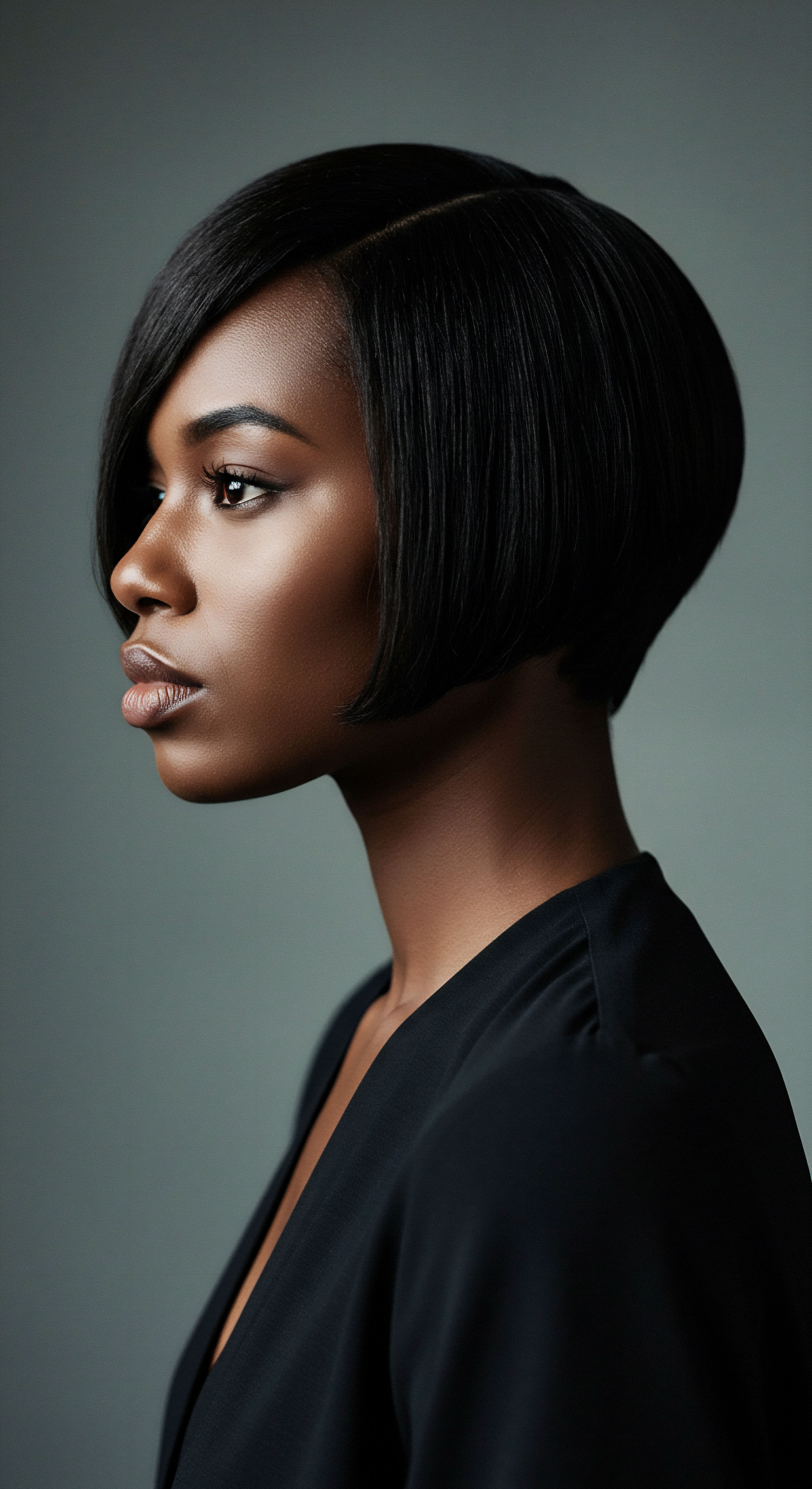
Roots
The quiet hours of night, often perceived as a time of stillness and repose, hold a subtle yet significant impact on the vitality of our hair. As the world around us settles into slumber, our strands, particularly those with a beautiful coil or curl, engage in a silent struggle against the very surfaces meant for rest. This nocturnal interaction, often overlooked, can determine the next day’s texture, moisture levels, and overall appearance.
Understanding the fundamental science of hair hydration and the mechanics of nightly friction lays the groundwork for truly protective care. It is a quiet truth, a foundational wisdom that invites us to reconsider our evening rituals, moving beyond mere habit to a conscious act of preservation.

The Hair’s Delicate Structure
Each strand of hair, a marvel of biological design, possesses a complex architecture. At its outermost layer resides the Cuticle, a series of overlapping scales, akin to shingles on a roof. When these scales lie flat and smooth, they reflect light, creating a lustrous appearance, and more importantly, they act as a barrier, sealing moisture within the hair’s inner core, the cortex. This protective outer layer is the first line of defense against dehydration and external stressors.
However, this cuticle, despite its protective role, is remarkably delicate. Physical interactions, such as rubbing against surfaces, can cause these scales to lift, chip, or even break. When the cuticle is compromised, the hair’s inner moisture readily escapes, leading to dryness, frizz, and increased susceptibility to damage. This vulnerability is particularly pronounced in textured hair, where the natural bends and twists of the strand create more points of contact and, consequently, more opportunities for friction to occur.

Why Hair Loses Moisture Overnight
Our hair, much like our skin, is in a constant dialogue with its environment. During sleep, several factors conspire to deplete its precious hydration. The primary culprit is often the bedding material itself. Conventional pillowcases, frequently made of cotton, possess a highly absorbent nature.
These fibers act like tiny sponges, drawing away natural oils and applied moisturizers from the hair strands as we move through the night. This absorption leaves the hair dry and brittle, priming it for damage.
Beyond absorption, the friction generated by movement during sleep plays a significant role. The average person shifts position numerous times each night, creating repeated rubbing between the hair and the pillowcase. This mechanical action, when combined with the weight of the head, can abrade the hair’s outer layer, lifting those delicate cuticle scales. A compromised cuticle cannot hold moisture effectively, leading to accelerated dehydration and an increased likelihood of tangles, frizz, and breakage by morning.
Hair’s outer layer, the cuticle, acts as a moisture shield, but its delicate scales are vulnerable to nightly friction and absorbent bedding.

The Science of Surface Interaction
The interaction between hair and a sleeping surface is a matter of tribology, the science of friction, lubrication, and wear. Different materials exhibit varying coefficients of friction, which dictates how much resistance they present to hair movement. Coarser fabrics, like cotton, create higher friction, causing hair strands to snag and pull. This tugging can lead to micro-tears along the hair shaft and disruption of the cuticle.
Conversely, smoother materials allow hair to glide with minimal resistance. This reduced friction is paramount for preserving the hair’s structural integrity and its moisture balance. When hair can move freely, without snagging or pulling, the cuticle remains intact, and the hair’s natural oils and applied products stay where they belong ❉ on the hair.
| Hair Layer Cuticle |
| Function Outer protective scales, seals moisture |
| Nightly Stressors Friction from rough surfaces, moisture absorption by fabric |
| Consequence Lifting, chipping, or breakage of scales; moisture loss |
| Hair Layer Cortex |
| Function Inner core, provides strength and elasticity |
| Nightly Stressors Dehydration due to compromised cuticle |
| Consequence Brittleness, reduced elasticity, increased breakage |
| Hair Layer Natural Oils |
| Function Lubrication, moisture barrier |
| Nightly Stressors Absorption by pillowcase materials |
| Consequence Dryness, dullness, increased susceptibility to damage |
| Hair Layer Understanding how nightly interactions affect hair layers is foundational to protective care. |

Ritual
As the sun dips below the horizon, signaling the day’s close, a different kind of preparation begins for those who seek to honor their hair’s vitality. The transition from active hours to quiet repose calls for practices that actively safeguard our strands. This evening ritual, often a serene moment of self-care, transforms the simple act of sleeping into an opportunity for hair preservation. It is a conscious choice to shield our hair from the rigors of the night, ensuring it awakens refreshed and ready for the day ahead.

The Choice of Covering Material
The material that touches our hair during sleep holds significant sway over its hydration and integrity. Among the array of choices, two stand out for their protective qualities ❉ Silk and Satin. While often used interchangeably in common conversation, they possess distinct characteristics that contribute to their efficacy.
- Silk ❉ A natural protein fiber, silk is celebrated for its incredibly smooth surface and its low absorbency. Its protein structure, similar to that of hair, allows strands to glide effortlessly across its surface, significantly reducing friction. This minimal friction helps to keep the hair cuticle smooth and closed, thereby retaining moisture within the hair shaft. Moreover, silk’s inherent breathability prevents heat and moisture from becoming trapped, contributing to a balanced environment for the scalp and hair.
- Satin ❉ Distinct from silk, satin refers to a type of weave, not a fiber. While satin can be made from silk, it is often produced from synthetic fibers like polyester or nylon. Regardless of its fiber composition, the satin weave creates a smooth, lustrous surface that offers considerable benefits over coarser materials like cotton. This smoothness helps reduce friction, minimizing tangles, frizz, and breakage. While synthetic satin may not offer the same breathability or moisture retention properties as natural silk, it remains a far superior choice to cotton for hair protection.
Cotton, in contrast, with its absorbent and somewhat coarse fibers, tends to draw moisture from the hair and create friction, leading to dryness and potential damage. The distinction between these materials is not merely one of luxury but of functional benefit for hair health.

Head Wraps and Bonnets
Beyond pillowcases, dedicated hair coverings offer an added layer of protection. Bonnets and Scarves, particularly those crafted from silk or satin, encase the hair, creating a protective cocoon. This enclosure ensures that the hair is shielded from contact with bedding surfaces, further minimizing friction and moisture loss.
For many, especially those with textured hair, the use of a bonnet or scarf is not merely a practical step but a cherished tradition, passed down through generations. It is a ritual of care, affirming the need to protect and honor natural strands. These coverings help preserve curl patterns, reduce frizz, and maintain the hair’s moisture levels, extending the life of styles and reducing the need for daily manipulation.
Selecting silk or satin for sleep coverings, whether pillowcases or bonnets, creates a smooth sanctuary for hair, drastically cutting down on friction and moisture loss.

Overnight Styling Strategies
The manner in which hair is prepared before donning a covering also influences its nocturnal well-being. Simple, loose styles can further safeguard strands from tangling and breakage.
- Pineapple Method ❉ This popular technique involves gathering all hair into a very high, loose ponytail at the crown of the head, secured with a soft scrunchie or silk tie. The hair then cascades forward, resembling a pineapple, which keeps curls from being squashed and flattened underneath the head. This method minimizes friction on the length of the hair and helps maintain curl definition.
- Loose Braids or Twists ❉ For longer hair, creating one or two loose braids or twists before bed can prevent tangling and knotting. This method keeps the hair contained without causing tension on the scalp, which could lead to breakage. It also helps to maintain the hair’s natural curl pattern or create gentle waves.
- Moisturizing Before Bed ❉ Applying a lightweight leave-in conditioner or hair oil before covering the hair provides an additional shield against dehydration. This step helps to seal the hair cuticle and replenish any moisture lost during the day, ensuring the hair remains hydrated throughout the night.
These practices, when combined with the right sleep covering, create a comprehensive nighttime regimen that prioritizes hair health. It is a quiet testament to the understanding that consistent, gentle care yields lasting radiance.
| Material Silk |
| Texture Very smooth, natural protein fiber |
| Moisture Absorption Low |
| Friction Reduction Very high |
| Breathability High |
| Material Satin (Synthetic) |
| Texture Smooth, synthetic weave |
| Moisture Absorption Moderate |
| Friction Reduction High |
| Breathability Moderate |
| Material Cotton |
| Texture Coarse, natural fiber |
| Moisture Absorption High |
| Friction Reduction Low |
| Breathability High |
| Material Choosing materials with low friction and low absorption is paramount for preserving hair hydration. |

Relay
To truly comprehend the significance of sleep coverings for hair hydration, one must transcend the mere practicalities and delve into the deeper currents of cultural heritage, scientific inquiry, and the nuanced interplay of human biology with daily practices. This exploration moves beyond the immediate benefits, seeking to connect the individual act of nightly hair protection to broader historical contexts and the latest scientific insights. It is a dialogue between ancestral wisdom and contemporary understanding, revealing a richer narrative of care.

Cultural Continuities of Hair Protection
The practice of covering hair at night, particularly within Black and mixed-race communities, is far from a modern trend; it is a deeply rooted tradition, a legacy passed through generations. This ritual holds cultural significance, reflecting not only practical hair care but also identity, resilience, and self-regard. From ancient African civilizations, where hair styles communicated social status and spiritual connections, to the experiences of the diaspora, head coverings served multiple roles.
During periods of immense adversity, such as slavery, headwraps became a quiet act of resistance and a means of preserving cultural identity amidst forced assimilation. While oppressive laws in some regions sought to demean Black women by enforcing hair coverings, these women redefined the headwrap as a bold declaration of dignity and pride. This historical context lends a profound weight to the simple bonnet or scarf, transforming it into a symbol of enduring heritage and self-love. The practice, then, is not solely about physical protection; it is a continuation of ancestral wisdom, a daily reaffirmation of one’s cultural lineage and inherent worth.
Nightly hair coverings are a continuum of cultural heritage, particularly for textured hair, embodying centuries of protective wisdom and identity.

The Biophysics of Hair and Friction
Beyond cultural observance, rigorous scientific investigation provides compelling reasons for prioritizing low-friction sleep surfaces. The hair cuticle, composed of keratinized cells, is susceptible to mechanical stress. When hair rubs against a rough surface, the friction generates forces that can lift, chip, or even remove these protective scales. This process, known as abrasion, directly compromises the hair’s ability to retain moisture.
Research in tribology, the study of interacting surfaces in relative motion, highlights the critical difference between various textiles. Cotton, with its irregular fiber structure, creates more points of contact and greater resistance as hair moves across it. Silk, by contrast, possesses a remarkably smooth and uniform fiber, resulting in a significantly lower coefficient of friction. This allows hair to glide rather than snag, preserving the cuticle’s integrity.
A study published in the Journal of the Textile Institute demonstrated that the coefficient of friction for hair against silk is notably lower than against cotton, contributing to reduced cuticle damage and thus better moisture retention. .

What Does Hair Friction Mean for Hydration?
The impact of friction on hair hydration is direct. When the cuticle is roughened or lifted, the hair becomes more porous. This increased porosity means that water molecules, whether from the air or from applied products, can more easily escape the hair shaft through evaporation. The hair effectively loses its seal.
Conversely, a smooth, intact cuticle acts as an efficient barrier, keeping internal moisture locked in and preventing external humidity from causing unwanted frizz or swelling. This principle underscores why materials that minimize mechanical disruption to the cuticle are superior for preserving hydration.

Challenging Conventional Wisdom
While the benefits of silk and satin are widely accepted, a deeper look reveals some less commonly discussed aspects. For instance, the very act of not covering hair, even on seemingly soft surfaces, can lead to subtle, cumulative damage. Many individuals, particularly those with straight or wavy hair, may dismiss the need for sleep coverings, believing their hair is less vulnerable. However, even minimal friction over hundreds of nights can contribute to split ends, dullness, and a general decline in hair health that is often attributed to other factors.
Furthermore, the notion that all “satin” is equal warrants scrutiny. While synthetic satin offers a smoother surface than cotton, it lacks the inherent breathability and protein structure of natural silk. Some synthetic satins can trap heat and moisture, potentially leading to a less ideal microclimate for the scalp and hair over prolonged periods. This highlights a nuanced point ❉ while a synthetic satin pillowcase is a considerable upgrade from cotton, true silk often provides superior benefits due to its natural properties, which include temperature regulation and a lower absorbency of natural oils.
A 2017 study in the International Journal of Cosmetic Science (though focused on skin) revealed a significant decrease in skin hydration after just one night of sleep deprivation, along with impaired barrier function. While this study did not directly measure hair, it offers a compelling parallel ❉ the body’s protective barriers, including the skin and, by extension, the hair cuticle, are compromised by adverse nocturnal conditions. This suggests that maintaining an optimal environment during sleep is paramount for overall integumentary health, extending to hair’s ability to retain moisture.
This scientific backing, combined with centuries of cultural wisdom, underscores the profound impact of sleep coverings. It is not simply about avoiding a bad hair day; it is about respecting the intricate biology of our strands and honoring practices that have long safeguarded their vitality.
| Covering Type Silk Pillowcase |
| Primary Benefit Maximum friction reduction, moisture preservation |
| Mechanism Smooth natural fibers allow hair to glide, low absorption |
| Considerations Higher cost, requires gentle care |
| Covering Type Satin Pillowcase (Synthetic) |
| Primary Benefit Significant friction reduction, some moisture preservation |
| Mechanism Smooth weave reduces drag, more accessible price point |
| Considerations Less breathable than silk, may trap some heat |
| Covering Type Silk/Satin Bonnet or Scarf |
| Primary Benefit Comprehensive hair enclosure, style preservation |
| Mechanism Completely isolates hair from bedding, prevents movement |
| Considerations May slip off, requires consistent wear |
| Covering Type Cotton Pillowcase |
| Primary Benefit None for hydration preservation |
| Mechanism High friction, high absorption of moisture |
| Considerations Can lead to dryness, frizz, breakage |
| Covering Type Strategic selection of sleep coverings directly influences hair hydration and integrity. |

Reflection
As the discourse around hair care deepens, moving from superficial remedies to a profound understanding of our strands, the seemingly simple choice of a sleep covering emerges as a cornerstone of hair wellness. It is a quiet act of self-care, a nightly promise to our hair that it will be protected, nurtured, and allowed to rest without undue strain. This mindful approach to nocturnal protection is not merely about avoiding frizz or preserving a style; it is about cultivating a lasting relationship with our hair, respecting its delicate nature, and honoring the heritage of protective practices that have sustained vibrant textures for generations. In the gentle embrace of a silk or satin covering, we find not just a shield against friction, but a space where hair can truly flourish, ready to greet each new day with renewed vitality.

References
- Schwartz, A. M. & Knowles, D. C. (1963). Frictional Effects in Human Hair. Journal of the Society of Cosmetic Chemists, 14 (9), 453-461.
- Bhushan, B. et al. (2014). Friction Dynamics of Straight, Curly, and Wavy Hair. Journal of the Royal Society Interface, 11 (98), 20140409.
- Harding, E. C. Franks, N. P. & Wisden, W. (2019). The Temperature Dependence of Sleep. Frontiers in Neuroscience, 13, 13.
- PLoS ONE. (2020). A laboratory-based study examining the properties of silk fabric to evaluate its potential as a protective barrier for personal protective equipment and as a functional material for face coverings during the COVID-19 pandemic. PLoS ONE, 15 (9), e0239531.
- El-Messiry, M. et al. (2017). Static Charge Accumulation and Its Relation to Friction and Damage in Hair. Journal of Cosmetic Science, 68 (2), 127-136.
- Obé Headwear. (2024). Significance of Headwraps. Retrieved from Obé Headwear website.
- Williams, M. (2021). How a Hair Wrap Routine Protects More Than Just My Hair. Sleep.com .
- Sonson. (2021). The History of Headwraps and Black Culture. Retrieved from Sonson website.
- Wilderness Safaris. (2015). The history & meaning of head wraps across Africa. Retrieved from Wilderness Safaris website.
- International Research Journal of Modernization in Engineering Technology and Science – IRJMETS. (2025). Retrieved from IRJMETS website.
- Amerisleep. (2024). Benefits of Sleeping in a Bonnet ❉ Why You Should Do It. Retrieved from Amerisleep website.
- Little Extra. (2023). How to Prevent Split Ends While Sleeping. Retrieved from Little Extra website.
- Helix Hair Labs. (2023). Is Hair Breakage Happening While You Sleep? Retrieved from Helix Hair Labs website.
- Blissy. (2025). Is Silk or Satin Better for Hair? TikTok’s Viral Hack vs. Science. Retrieved from Blissy website.
- Dariia Day. (2025). Silk vs. Cotton & Satin ❉ What’s the Best Fabric for Your Skin, Hair & Sleep? Retrieved from Dariia Day website.